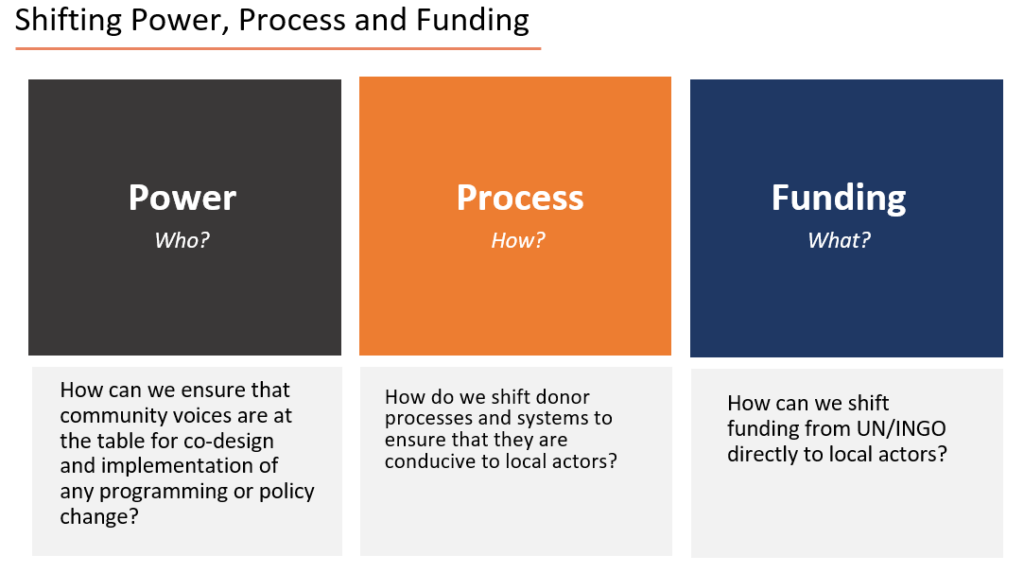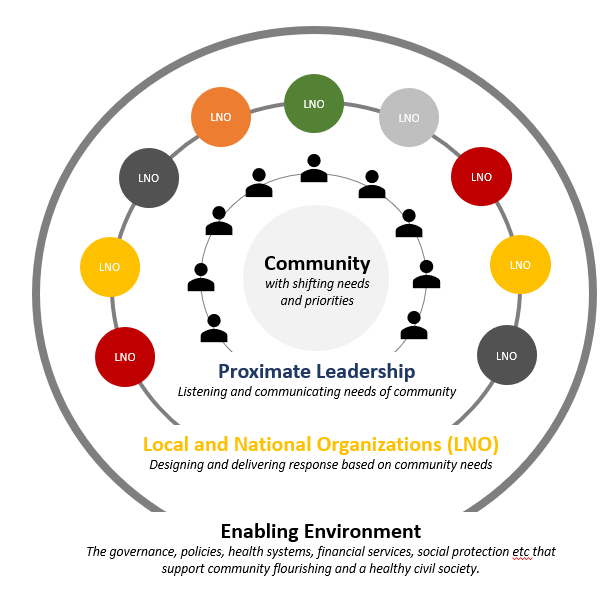What’s Stopping Aid from putting Local People and Organizations First? Answers from a Global Conversation

Courtenay Cabot Venton provides a snapshot of perspectives from a large group of Global South leaders…
The world is currently at an inflection point that could enable the transformation of aid for developing countries. The convergence of the COVID-19 pandemic and the Black Lives Matter movement, as well as the withdrawal of most international staff across the globe, has opened up space for more honest conversations around racism and the decolonization of aid. Talk of localization and a more direct shift of resources and power to local communities has garnered significant attention. The most common questions that I hear people ask are, “Why now? What is different? Are things really going to change?”
I have been helping to lead the FCDO’s (UK Government’s Foreign Commonwealth and Development Office) expert advisory team on their global COVID-19 response. Localization has been a prominent and consistent theme. From a very practical perspective, we have had to reckon with a massive increase in social protection funding to 1.8 billion new people to help them cope with the effects of lockdown. The role of local actors – people who are known and trusted by their communities – has been critical to sensitize communities, minimize exclusion, ensure accountability and transparency, and communicate and mitigate risks. We have seen countless examples of local actors leading in the response:
Zakat networks in Occupied Palestinian Territories (OPT) raised and distributed $17 million in May 2020 to support workers and families, months before World Bank funding was approved and disbursed;
SEWA –a network of over 2 million self-employed women in India –played a key role in facilitating government aid, informing members what they were entitled to, how to apply, as well as approaching local government officials on members’ behalf.
Despite their critical role, the official aid sector has failed at placing these local networks at the forefront. Most international support to local actors currently comes from private philanthropy, which accounts for just five percent of all Official Development Assistance (ODA). This means local actors have to spend precious time and energy competing for just a sliver of the pie. If local people and their organizations are going to take a central role, mechanisms to leverage more funding from bilaterals – who account for over 95% of ODA – are key.

Our team has been leading a series of convenings with a large group (100+) of Global South leaders, private philanthropy and bilateral government donors. Here is a snapshot of perspectives from across this group…
From Monica Nyiraguhabwa, Founder and Executive Director, Girl Up Uganda
As a leader of a community-based organisation in the Global South, the biggest challenge I face revolves around navigating existing power structures, which are oftentimes subtle and seemingly invisible, but always prove to be extremely disempowering. It can feel as though you are sitting at a table where everyone is discussing you, your challenges, and solutions to your challenges, but you are not welcome to contribute to the conversation. The current environment reinforces the antiquated narrative that philanthropy is transactional —the ‘now this is what I expect from you’ dynamic.
If one truly believes in investing in humanity and global equity then an authentic appreciation and trust in community-driven and led solutions must be developed (and invested in!). Additionally, individuals working in this space have to be comfortable with challenging personal biases and stereotypes and then put in the hard work to unlearn and reimage what giving up and redistributing power looks like. Because power is at the core, and everyone has a crucial role to play in disrupting the cycle.
From Peter Laugharn, President and CEO, Conrad N. Hilton Foundation
No matter where we sit in the funding landscape, we should all continually be asking ourselves whether the right people are at the table. The most effective solutions come from the very people experiencing the issues we seek to solve. Unfortunately, the reality is that they are often excluded from decision making that has a direct impact on them.
We must fundamentally shift the narrative from viewing communities as problems to solve to active contributors and experts — this starts with how we lift up the voices and portray the communities we are serving.
Philanthropy has a critical role as convener and facilitator. At the Hilton Foundation, there are three paradigm shifts we are looking to make. (1) Recognizing that lived experience is expertise – we engage directly with people with lived experience, and compensate them for this expertise. (2) Shift resources – we are increasing direct funding to local/community-based organizations; for example, we have committed that 25 percent of the Foundation’s Refugees strategic initiative will go directly to local and refugee-led organizations. (3) Build capacity – we are supporting technical assistance for local organizations to serve their communities. We believe this will ultimately build more sustainable solutions and resilient communities.

From Arjun Tasker, Portfolio Manager for the New Partnerships Initiative (NPI), USAID
USAID has sought to re-envision its role as a genuine partner, rather than distant financier, in supporting countries and communities to sustainably manage their own development, since the early 90s. Locally Led Development (LLD) at USAID is about pushing management, measurement, and decision-making to be as local as possible,.
No one across the agency thinks that LLD is a bad idea, but a range of institutional, operational, and legislative constraints have proven difficult to tackle. For example, the Agency is bound by the same rules for procurement as the Department of Defense uses; and Congressional spending earmarks constrain the ability of funding to meet local priorities (two-year money that has to be spent down within 8 months before it is swept doesn’t provide a lot of scope for the kind of longer term funding that facilitates effective LLD).
But there is still significant scope for change:how can the Agency give up power to local actors in addition to giving money?; require its traditional partners to incorporate plans for fostering accountability and consequential feedback with local populations; and ask traditional partners such as INGOs to reconstruct the ways in which they work to advance LLD?
The evidence indicates that limits on funding to local actors is largely based on a variety of perceived constraints. These constraints are not only context-specific, but also reflect a ubiquitous perception of limitations, but without much evidence that they actually exist. They include: the perceived inability of local actors to absorb fiduciary, reputational and operational risk; to operate at scale and deliver multi-dimensional funding; and provide multi-dimensional programming that meets due diligence requirements.
Bilateral requirements to fund only through one or two intermediary structures eliminates the possibility of funding multiple smaller local actors. We need to re-conceptualise intermediary roles and structures. Private philanthropy also needs to bring its leveraging power to the table – using its flexibility to invest in new ways of working and building proof points to shift donor processes.
One of our biggest takeaways has been that we simply are not working together to collaboratively develop practical solutions that can move us beyond rhetoric. Our hope is that by having open and honest conversations about our realities and how we can start to bridge this gap, we will start to see meaningful change.
Courtenay Cabot Venton is an international development economist. By demonstrating the relative returns of social and environmental interventions, she creates an evidence base for what works and what doesn’t when it comes to reducing poverty worldwide.
This post first appeared on From Poverty to Power.
Image: FCDO via Flickr (CC BY 2.0)


